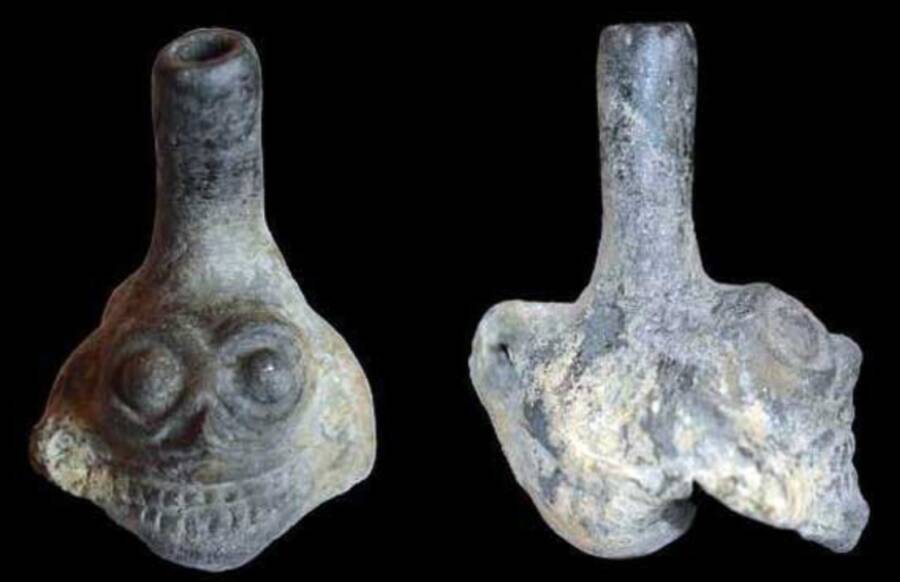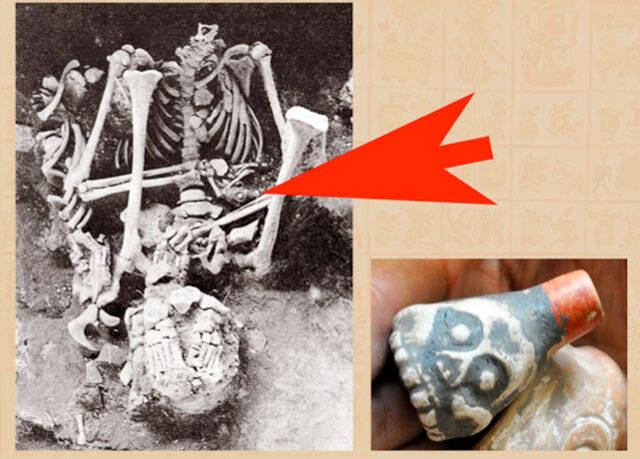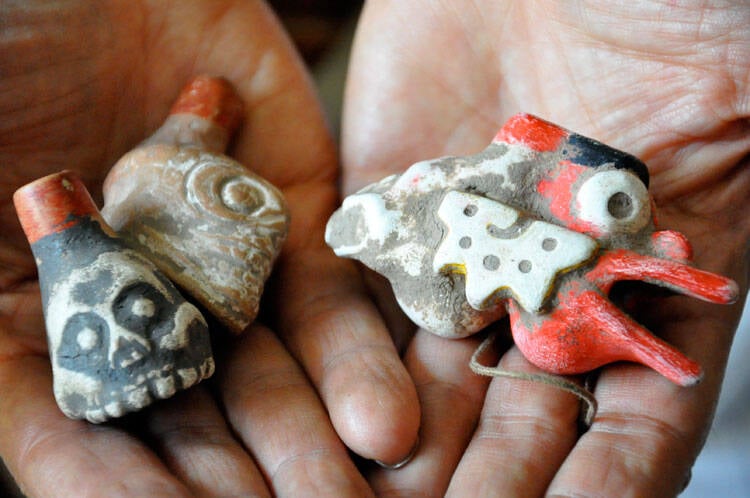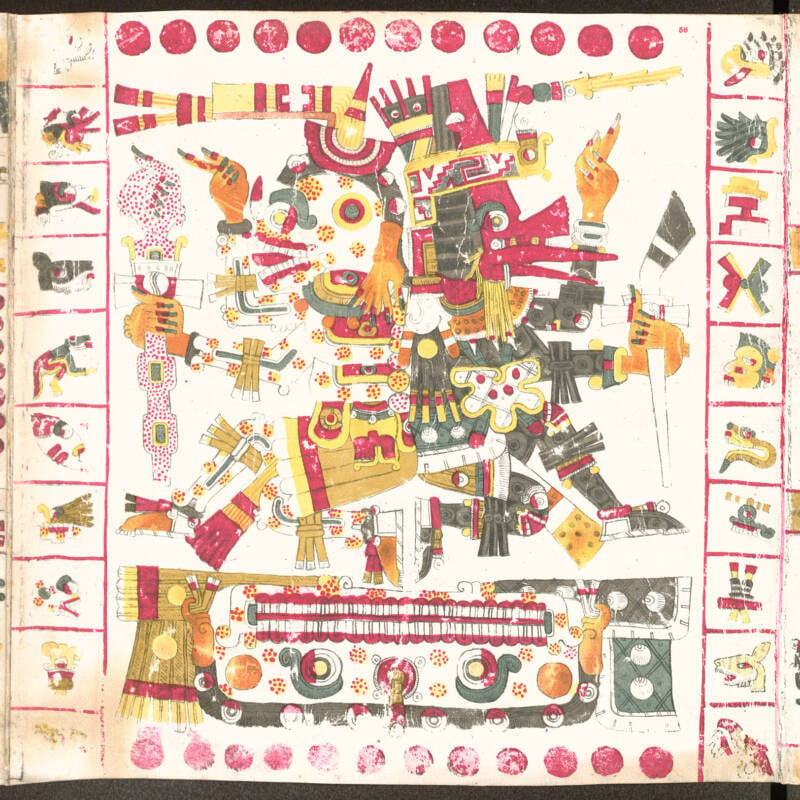While some have theorized that ancient Mesoamericans used the Aztec death whistle to terrify their enemies during battle, experts are still unsure what exactly these skull-shaped instruments were really used for.

Wikimedia CommonsThe ehecachichtli, more commonly known as the “Aztec death whistle,” became a point of public fascination in the 1990s.
In the late 1990s, a group of archaeologists discovered the skeleton of a human sacrifice victim within an ancient temple in Mexico City. Curiously, in each of its hands, the skeleton held a small ceramic whistle molded to look like a human skull. This discovery marked the beginning of a widespread fascination with the so-called “Aztec death whistle.”
In the years since, many have attempted to create knockoff copies of this enigmatic instrument. Content creators have taken to posting to YouTube, demonstrating the “terrifying” sound it purportedly makes. This noise has been likened to the shriek of a banshee, the howling wind, the screams of the damned, or the “wail of a thousand souls.”
These haunting cries have inspired a slew of theories about the whistles’ original purpose. Rumors have circulated online that Aztec warriors blew into these instruments during battle to strike fear into the hearts of their enemies. Others have suggested that the whistles may have been used to ward off evil spirits during human sacrifice.
Unfortunately, the truth is that experts don’t know for certain what purpose the whistles might have served — and many of the claims being circulated online seem to be unsubstantiated.
The Aztec Death Whistle Discovery
The mystery of the Aztec death whistle began in 1999. Then, a team of archaeologists led by Salvador Guillieum Arroyo were exploring the ruins of an ancient Aztec temple in Tlatelolco, Mexico City dedicated to the wind god Ehecatl.
It was here that they found the remains of the 20-year-old victim of a sacrificial ritual, clutching a pair of skull-shaped whistles.
This was not the first time such whistles had been found. In the 1970s, the historian José Luis Franco published the first analysis of similar whistles found in Mexico. Through his drawings, Franco demonstrated that most of the whistles were fashioned into the shape of either a skull or an owl, a creature associated with death in various Mexican cultures.
But before Arroyo’s 1999 discovery, no other such whistle had been found within its archaeological context.

Roberto Velázquez CabreraThe original skeleton found with the death whistles in 1999.
Arroyo and his team soon realized that the ceramic whistles were meant to depict another Aztec god: Mictlantecuhtli, the god of the underworld and death. Hence, the instruments came to be known commonly as “Aztec death whistles.” They are also known as ehecachichtli, after the wind god Ehecatl.
While it was clear that these whistles had some sort of ceremonial or spiritual purpose, researchers still don’t know what the ancient Aztecs used them for. In fact, experts were not even sure what these instruments might have sounded like when played by an Aztec priest or musician
Then, in the early 2000s, a music archaeologist by the name of Arnd Adje Both received the opportunity to play the whistles.
What Does The Aztec Death Whistle Sound Like?
Arnd Adje Both had long harbored a fascination with the instruments and musical culture of pre-Columbian societies. Given his expertise, he was granted the honor of being the first person to play the Aztec death whistles Arroyo’s team had uncovered in 1999, in the hopes that he might be able to recreate, with some accuracy, their intended sound.
While the sounds produced by knockoff Aztec death whistles in recent YouTube videos are akin to bloodcurdling screams, Both produced a sound that was similar to the wind, but slightly distorted.
His interest piqued, Both then took CT scans of the death whistles to create his own replicas for further study. He later explained what he discovered in an interview with How Stuff Works.

Roberto Velázquez CabreraModern Aztec death whistle replicas makes a sound like a high-pitched shriek.
He described the whistles as a type of “air spring” whistle, which were first invented by the Maya around 700 to 800 C.E. Air springs such as these have a rounded chamber on the inside, which creates a distorted sound, as well as an opening on the bottom that can produce various tones depending on how the player cups their hands.
Both noted that air spring whistles “don’t fit into the Western classifications of wind instruments… which means that they’re singular worldwide and only produced in pre-Columbian America.”
To this day, only a few genuine examples of death whistles have ever been found. However, one researcher, Roberto Velázquez Cabrera, has dedicated years of research to the instruments — and provided some historical context regarding their purpose.
Possible Uses For These Mysterious Instruments
Writing for the site Mexicolore in 2011, Roberto Velázquez Cabrera drew a connection between Ehecatl and Mictlantecutli that could explain, to some degree, what the ritual purpose of the death whistles could have been.
Because the 1999 whistles were found in an Aztec temple dedicated to the wind god Ehecatl, and because of the eerie, wind-like sound they purportedly make, Cabrera suggested they may have been used in rituals related to Ehecatl. If a ritual called for wind — or, at the very least, the sound of strong wind — then perhaps the instruments could have been used to evoke the wind because “a strong wind cannot simply be summoned whenever the occasion requires.”
Mictlantecutli and Ehecatl were also strongly intertwined in Aztec belief. One page of the pre-Columbian Mesoamerican document the Codex Gorgia features an illustration of the two gods standing back-to-back at the entrance of the underworld.
What’s more, Lewis Spence’s 1913 work Myths of Mexico and Peru makes a brief mention of a similar whistle. While it is unclear if he is directly referring to the Aztec death whistle, he does draw a connection between the instrument and the sound of wind.
Spence writes of a “most remarkable festival in connection with Tezcatlipoca,” the creator god, during which a “youth was slain who for an entire year previously had been carefully instructed in the role of victim.” The sacrifice was to assume “the name, garb, and attributes of Tezcatlipoca himself” and carry a whistle that made “a noise such as the weird wind of night makes when it hurries through the streets.”

Wikimedia CommonsThe wind god Ehecatl and the god of death, Mictlantecutli.
There are also a number of Aztec beliefs relating to the dangers of crossing over into the afterlife. To prepare the deceased for this arduous journey, the whistles may have been used in rituals to ward off evil spirits or give the deceased strength for the trek.
Meanwhile, there is virtually no evidence that Aztec death whistles were used as an intimidation tactic in battles, as many online would suggest.
What The Internet Gets Wrong About Aztec Death Whistles
In recent years, at-home 3D printing technology has become more accessible than ever before, allowing people around the world to share their creations with others at little expense. Because of this technology, imitation versions of the Aztec death whistle have popped up in countless online stores.
Popularized on YouTube, these replicas have been made in all shapes and sizes and even come in Lovecraftian or otherwise horror-themed variants. And unlike the authentic whistles, many of these instruments produce a ghastly, frightening shriek.
With the popularity of Aztec death whistles on the rise, so too is speculation about their history. Many online users have circulated the theory that Aztec warriors blew into these whistles during battle to terrify their enemies. But aside from the fact that the sound the whistles make is terrifying, there seems to be no real evidence to support this.
“There’s no proof, but it’s still a possibility,” Both told How Stuff Works. “Up to this point, we haven’t excavated an individual classified as an Aztec warrior with such an instrument around their neck.”
All that experts really know about these strange, ancient whistles is that they likely had some sort of ritualistic significance. The rest is still a mystery.
After learning about the Aztec death whistle, explore the history of human sacrifice in pre-Columbian America. Or, learn about Xipe Totec, the Mesoamerican god of human flaying.





